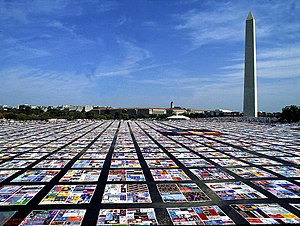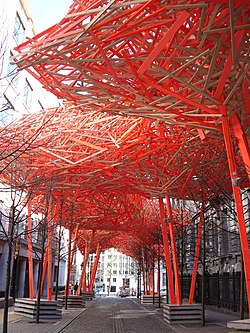The artistic process/ART101/Art as social activity
A more contemporary example of art making as a community effort is the AIDS Memorial Quilt Project. Begun in 1987, the project memorializes the thousands of lives lost to the disease through the creation of quilts by families and friends. Blocks of individual quilts are sewn together to form larger sections, virtually joining people together to share their grief and celebrate the lives of those lost. The project is evidence of the beauty and visual spectacle of a huge community artwork. Today, there are over 40,000 individual blocks. The quilt project is ongoing, growing in size, and exhibited throughout the world.
After the selection process the artist will commence on an intense collaboration with architects, engineers, public administrators and others connected with the project, ultimately resulting in the installation of a public artwork. Because of its complexity this process needs to be expertly managed. Other countries have similar programs. All of them allow individual artists and collaborative teams the chance to put a definitive creative stamp on public spaces.
Public art projects can be subject to controversy. It's not easy for everyone to agree on what constitutes "good" or "bad" art, or at least what is appropriate for a public space. The issue takes on a more complex perspective when public money is involved in its funding.
One example of a controversial public work of art involves Richard Serra's sculpture Tilted Arc installed in 1981. Read the following essay describing the controversy and the outcome:
- Richard Serra's Tilted Arc, Culture Shock, PBS, USA
Time, money, a space to work in, a supportive family and public, a culture that respects skill and values creativity and expression: all of these are required for the artist to thrive. What does an artist give back to society? They give voice to speak of those things that language cannot describe, and an experience that pays attention to aesthetics and an interest in the world. They give expression to what it is to be human in all its positive and negative forms. A wonderful example of this is provided in the photography of Don Tremain. His "Salty Dogs" series of black and white images featuring country musicians quietly speaks to the power of music and the aesthetic image in art and their connection to community, place and the singular creative act.
If you have access to others studying this course, try to find and pair up with another student with whom you can collaborate. If not, do this by yourself and write your comments in the course feed or in your journal.
Compare and contrast art created as a social activity and as a singular creative act.
- What are the differences?
- Why are they important?
- Do their functions ever overlap? How?
Here are some resources to help you with this exercise:
- The Quilts of Gees Bend
- Michael Hayden's Sky's the Limit , also this video.
- AIDS quilt project
- Mexico's Day of the Dead celebration.
- Still life painting
- Large scale sculpture
- Photography
Be sure to cite any sources you might use, and include links to any images you use.
Note: Your comment will be displayed in the course feed.

